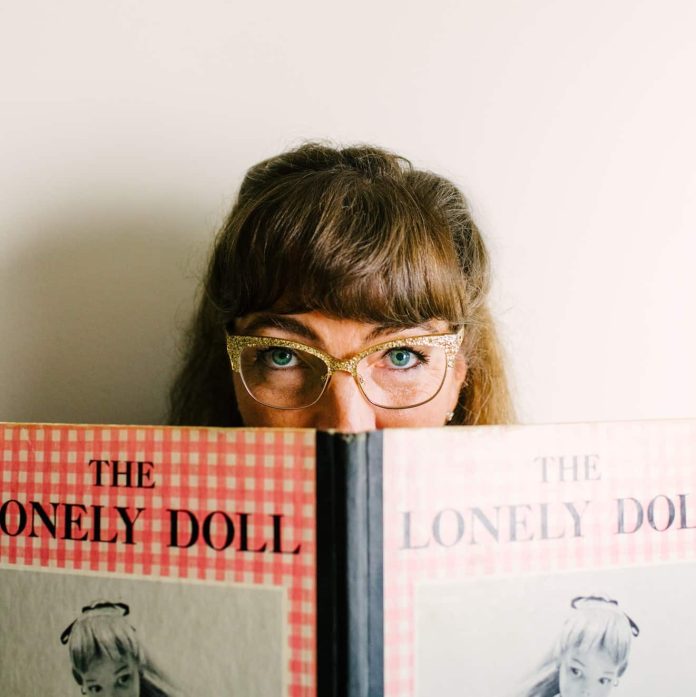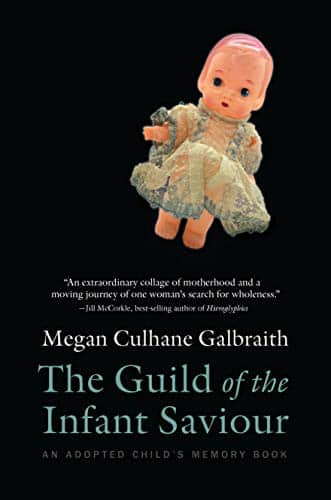By Megan Culhane Galbraith
As a little girl I’d lie flat on my back and pour over The Lonely Doll. It was an oversized picture book with a pink gingham cover that featured a black and white photo of a doll sitting on the floor holding an open book. The author, Dare Wright, posed her Lenci doll, “Edith,” in various scenes inside her own glamorous New York City apartment, the park, the Brooklyn Bridge and beyond. Like Dare, the doll was pretty, blonde, with bangs and a high ponytail. She seemed a charmed life, but there was one problem. Edith was terribly lonely.
Wright was an amateur photographer and The Lonely Doll was her first book. The Lenci doll that represented Edith was the doll she’d played with as a child. Edith was Dare’s doppelgänger. In the book Edith’s parents are never home and she is essentially orphaned, wandering the huge apartment, staring out the window, hoping for friends to play with when suddenly two friends show up at her door, Mr. Bear and Little Bear.
I loved Edith, but what saddened me was her expression. Her eyes seemed searching and vacant. Her mouth was pursed in a way that implied a smile she wasn’t capable of giving. It’s no wonder Wright’s book influenced my work in deep ways. We were both searching for how to belong.
In my memoir-in-essays, The Guild of the Infant Saviour: An Adopted Child’s Baby Book, I recreate and photograph scenes from my baby book in my dollhouse similar to the way Wright did. My visual art project, The Dollhouse, became a lens through which I could safely question my personal history and interrogate the myths of adoption and identity. As an adopted child, I’d felt like a thing to be played with––a doll––instead of a person with her own identity. I’d felt looked at, but not seen. Playing in the dollhouse helped me reconstruct my identity after feeling invisible for many years. It helped me build a safe home within myself because for a long time I’d never felt truly at home anywhere, not even in my own body.
Children play to control the world. When I was a child, I wanted to control my world because as an adoptee I felt I had no control. I created small universes in shoebox dioramas in grade school, and built tiny natural habitats for the mice that lived in the field behind my house. I loved to create and explore new miniature realms. It was empowering to make all the decisions, so I imagined myself into another life. It didn’t matter that the stage was tiny. These were worlds into which I could disappear.
Dolls have no agency; they are objects to be acted upon. I didn’t play much with dolls as a child. I hadn’t been given dolls as a girl––no Barbie, or Baby Alive. My parents gave me Legos, a rock tumbler, and a frog hatchery, all of which dazzled me. Each Christmas, Mom gave me one Madame Alexander doll, which I was urged to keep pristine in its box. The one doll I remember playing with was Holly Hobbie. Holly had flat feet and a flat chest like me, and her dress was reminiscent of what Laura Ingalls wore in “Little House on The Prairie,” a show I watched religiously every Sunday. Holly’s tagline was “Start Each Day In a Happy Way.” She had a huge head, oversized eyes, chipmunk cheeks . . . and no mouth. She couldn’t have spoken if she’d wanted to.
I hated her.
One day, after cutting her hair so short it stuck straight up from her head, I tried to decapitate her. I held her flat feet and banged her giant head against the corner of my desk. When that didn’t work, I grabbed her head and tore it off with my hands. I realize now how angry I was that I couldn’t express my fear, or loneliness. It was there, living inside me all along but I didn’t have the words. I felt sad, emotionally fragile, and invisible when all I needed was to be held and comforted.
Years later, I began playing with a tin dollhouse I’d found at a local antique shop; A ’60s-era Louis Marx “Marxie Mansion” of the same time period in which my birth mother had been sent away to have me. That set the stage for what would become the basis for a visual art project called “The Dollhouse.” I staged the dolls and babies in household situations and photographed them from the outside looking in, just like Dare Wright did in The Lonely Doll. It was a voyeuristic way of seeing a situation from an angle of removal. It gave me the space I needed to examine my adopted life through a different lens. Thanks to those dolls I began to reconstruct and reclaim my identity.
“No one gets a dollhouse to play at reality,” said the child psychologist Erik Erickson, “but reality seeps in everywhere when we play.”
The New Yorker deemed The Lonely Doll “The Creepiest Children’s Book,” and it has a cult following, but I don’t find it creepy at all. There’s a controversial scene in the book. Edith is thrown over Mr. Bear’s knee and spanked for being “naughty” for trying on her mother’s lipstick. Keep in mind it was Little Bear who provoked her to wear the lipstick and who wrote, “Mr. Bear is a silly old thing” on the boudoir mirror in that same lipstick.
Adults project eroticism on to that spanking scene (because adults ruin everything), but it was more about punishing a girl for showing her feelings than it was about kink. Why was Edith being disciplined for expressing a feeling and trying to connect with her absent mother? It was Little Bear who deserved that spanking. In my child brain I thought, “If a doll could get spanked for doing something “naughty” like expressing her feelings, then surely I’d better be a good girl and not make anyone angry.”
Writing this essay sparked a memory of my Dad coming into my room one night. He sat on the side of my bed and without introduction said, “Your mother and I have discussed it and we’ve decided you’re too old to spank anymore.” I don’t remember what prompted him to make that announcement, or what he said afterward. I just remember feeling mute and wanting to pull the covers over my head.
As I considered the structure of my memoir-in-essays, I needed to tell my story in a fractured way, which is the way we adoptees get our information, either filtered through the fog of someone else’s memory, or obfuscated by secrets and lies. Dare Wright was telling her story through her doll Edith too. She was asking to be seen, truly seen, beyond her beauty and beyond what looked outwardly like a glamorous life.
D.W. Winnicott, a British psychologist, called the dolls, blankets, and stuffed animals children often have as “comfort objects.” These objects helped a child manage the stress of the mother not being there and allowed them build the confidence needed to become independent.
In The Dollhouse I created a world where women rule on a 1:12-scale. It became a portal to imagine myself into my birth mother’s life and her into mine. Playing with these dolls was also a way of managing a thorny relationship with my birth mother while grieving for my long-dead Mom. Comfort objects, indeed.
“Children are innocent before they are corrupted by adults,” said the child psychologist Eric Erickson, “although we know some of them are not and those children––the ones capable of arranging and re-arranging the furniture and dolls in any dollhouse––are the most dangerous of all. Power and innocence together are explosive.”
The Lonely Doll helped me feel seen. It was an influential book that gave me a window into the loneliness brought on by my adoption, and the feelings of numbness and invisibility. I realize now that I don’t need to apologize for my existence.
My greatest desire is to be fully seen.
Megan Culhane Galbraith is a writer, visual artist, and an adoptee. She is the author of The Guild of the Infant Saviour: An Adopted Child’s Memory Book, a hybrid memoir-in-essays published by Mad Creek Books. Her work was Notable in Best American Essays 2017 and her writing, interviews, and art have been published in HYPERALLERGIC! Severance Magazine, ZZYZZVA, Tupelo Quarterly, Parhelion, Hobart, Longreads, Hotel Amerika, Catapult, and Redivider, among others. She is a graduate and the Associate Director of the Bennington Writing Seminars, and the founding director of the Governor’s Institutes of Vermont Young Writers Institute. Follow Megan on her website or facebook. She can also be found on Twitter as @megangalbraith and on Instagram as @m.galbraith and @the_d0llh0use.
Buy The Guild of the Infant Savior: An Adopted Child’s Memory Book at Bookshop.org or Amazon.
Check out the Lonely Doll book here.
~~~~~~~~~~~~~~~~~~~~~~~~~~~
Megan Galbraith is a writer we keep our eye on, in part because she does amazing work with found objects, and in part because she is fearless in her writing. Her debut memoir-in-essays, The Guild of the Infant Saviour: An Adopted Child’s Memory Book , is everything we hoped from this creative artist. Born in a charity hospital in Hell’s Kitchen four years before Governor Rockefeller legalized abortion in New York. Galbraith’s birth mother was sent away to The Guild of the Infant Saviour––a Catholic home for unwed mothers in Manhattan––to give birth in secret. On the eve of becoming a mother herself, Galbraith began a search for the truth about her past, which led to a realization of her two identities and three mothers.
This is a remarkable book. The writing is steller, the visual art is effective, and the story itself is important.
Pick up a copy at Bookshop.org or Amazon and let us know what you think!
~~~~~~~~~~~~~~~~~~~~~~~~~~~
Anti-racist resources, because silence is not an option
~~~~~~~~~~~~~~~~~~~~~~~~~~~


